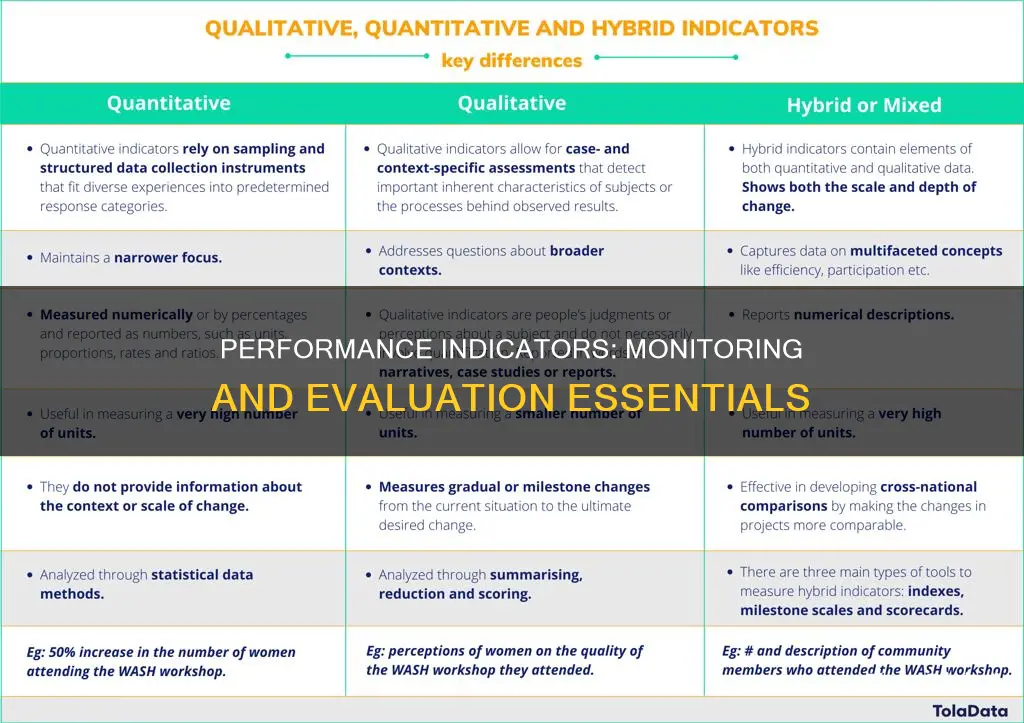
Performance indicators are a crucial aspect of monitoring and evaluation (M&E) in project management. They are specific, measurable, and observable data points that track and assess the progress and performance of a program or intervention. Performance indicators provide insights into how well a project is performing, whether it is meeting its objectives, and what actions can be taken to improve outcomes. They are an essential tool for project managers to make informed decisions, identify risks, and allocate resources effectively.
Performance indicators can be qualitative or quantitative and are typically aligned with the specific goals and objectives of the project. They are selected in advance and measured throughout the project lifecycle to evaluate success and identify areas for improvement. Examples of performance indicators include input indicators, output indicators, outcome indicators, and efficiency indicators, each providing a different perspective on the project's performance.
| Characteristics | Values |
|---|---|
| Measurable | Provide information about the performance of a project |
| Specific | Relate to the achievement of an objective and only that objective |
| Observable | Provide information about the inputs, activities, outputs, outcomes, and impact of the program or intervention |
| Data points | Used to monitor and evaluate progress towards achieving specific goals and objectives |
| Qualitative or quantitative | Measure changes over time and assess the effectiveness of interventions |
| SMART | Specific, Measurable, Achievable, Relevant, and Time-bound |
| Feasible | Consider the availability of data and resources |
| Meaningful | Selected indicators are appropriate for the actions being implemented |
What You'll Learn

Types of performance indicators
Performance indicators are an essential component of monitoring and evaluation (M&E), providing a basis for measuring progress, identifying successes and challenges, and informing decision-making. They are specific, measurable, and observable data points that help to track and assess the progress and performance of a program or intervention.
There are several types of performance indicators that can be used in M&E, including:
Input Indicators
Input indicators measure the resources and inputs required to deliver a program or project. They provide information about the investment in a program, project, or intervention, and are typically used to assess efficiency. Examples include budget, personnel, materials, equipment, and time. Input indicators offer valuable insights into the resources needed for implementation, but they do not measure outcomes or impact. Therefore, they should be used alongside other indicators for a comprehensive performance assessment.
Output Indicators
Output indicators focus on the immediate products or services resulting from a program or project. They provide information on the quantity and quality of goods or services produced and are typically used to evaluate the effectiveness of program or project implementation. Examples include the number of beneficiaries, quantity of products, timeliness, quality, and satisfaction of beneficiaries. While output indicators are useful for assessing performance in terms of immediate outputs, they may not capture the long-term outcomes or impact. Thus, they should be combined with other indicators for a fuller picture.
Outcome Indicators
Outcome indicators measure specific and measurable changes in behaviour, knowledge, skills, attitudes, or conditions resulting from a program or project. They provide insights into the intended and unintended consequences and are typically used to assess the effectiveness of the intervention. Examples include changes in knowledge, behaviour, skills, attitudes, or physical/social conditions of program participants. Outcome indicators help evaluate the effectiveness of a program in achieving its intended results, but they may not capture the long-term impact. Hence, they should be used with other indicators for a broader understanding.
Process Indicators
Process indicators focus on the activities, steps, or processes required to implement a program or project. They provide information on how a program or project is being executed and are typically used to assess the quality and efficiency of the implementation process. Examples include timeliness of implementation, adherence to procedures, quality of services, stakeholder engagement, and capacity building. Process indicators are valuable for assessing the quality and efficiency of implementation, but they may not reflect the long-term outcomes or impact. Therefore, they should be used in conjunction with other indicators for a complete performance evaluation.
Impact Indicators
Impact indicators, a specific type of performance indicator, measure the long-term, enduring effects of a program or project on a population or environment. They assess the broader, lasting changes brought about by the intervention. Examples include reductions in mortality rates, improved economic status of beneficiaries, and enhanced community resilience.
Efficiency Indicators
Efficiency indicators measure the relationship between resources used and results achieved. They assess the cost-effectiveness of a program or project and the efficient utilisation of resources. Examples include cost per participant, time taken to achieve outcomes, and resource utilisation rates.
Effectiveness Indicators
Effectiveness indicators measure how well a program achieves its intended objectives. They evaluate the degree to which targets are met and the level of stakeholder engagement. Examples include the percentage of targets met, success stories, and stakeholder engagement levels.
Quality Indicators
Quality indicators focus on the quality of program or project delivery, such as the satisfaction levels of beneficiaries. They assess whether the products or services meet the expected standards and the overall experience of those receiving the intervention.
Financial Indicators
Financial indicators measure the financial performance of a project, such as revenue, profit, or return on investment. They provide insights into the economic aspects and viability of the project.
Stakeholder Indicators
Stakeholder indicators measure the satisfaction or engagement of project stakeholders, including their participation, satisfaction, and support for the project. They evaluate the level of involvement and buy-in from those with a vested interest in the project.
The selection and combination of these performance indicators should be based on the specific goals and objectives of the project, ensuring a comprehensive understanding of its strengths, weaknesses, and areas for improvement.
Who Pioneered Blind Spot Monitors in Cars?
You may want to see also

How to choose performance indicators
Performance indicators, also known as key performance indicators (KPIs), are used to evaluate the success of an organisation's projects, programs, products and other initiatives. They provide a focus for strategic and operational improvement, and help to identify areas where improvements can be made.
When choosing the right KPIs for your organisation, it is important to consider the following:
- Understand your organisation's goals: KPIs should be aligned with the overall goals of your organisation. They should also be tailored to the specific department or function being measured. For example, KPIs for the finance department will differ from those for sales or marketing.
- Use a management framework: Applying a management framework, such as the balanced scorecard, can help structure the selection of KPIs. This ensures that the chosen KPIs are relevant and meaningful.
- Select measurable indicators: KPIs should be based on specific, measurable criteria. This could include financial metrics, such as revenue or profit margins, or non-financial metrics, such as customer satisfaction or employee retention.
- Set clear targets: Define specific targets for each KPI to establish a clear picture of what success looks like. This could include quantitative targets, such as increasing sales by a certain percentage, or qualitative targets, such as improving customer satisfaction ratings.
- Consider data availability: Ensure that the data needed to measure the KPIs is accessible and reliable. This may involve investing in analytics software or reporting tools to collect and analyse the necessary data.
- Involve stakeholders: Engage with relevant stakeholders, including employees, customers, and partners, when selecting KPIs. This helps to ensure that the chosen KPIs are feasible, relevant, and aligned with the organisation's goals.
- Prioritise and focus: Avoid choosing too many KPIs or measuring everything. Instead, prioritise the KPIs that are most critical to your organisation's success and focus on those.
- Use a mix of leading and lagging indicators: Leading indicators can help predict future outcomes, while lagging indicators track what has already happened. Using a combination of both types of indicators provides a more comprehensive view of performance.
- Review and adjust: Regularly review and revise your KPIs to ensure they remain relevant and effective. This may involve making changes based on market trends, customer feedback, or organisational goals.
By following these steps, organisations can choose effective KPIs that provide valuable insights, enable informed decision-making, and ultimately improve performance.
Connecting a Second Monitor: Easy CPU Setup Guide
You may want to see also

How to collect performance indicator data
Collecting performance indicator data is a critical aspect of monitoring and evaluation (M&E). This process involves tracking and evaluating key performance indicators (KPIs) to assess the success or progress of a project, programme, or organisation. Here are some steps and considerations for collecting performance indicator data effectively:
- Define clear goals and objectives: Start by establishing specific and clear goals and objectives for your project or organisation. This will help you identify the most relevant KPIs to track and ensure they are aligned with your strategic objectives.
- Select appropriate KPIs: Choose KPIs that provide meaningful insights and are tailored to your specific context. Common types of KPIs include financial, customer-focused, process-focused, output, outcome, efficiency, and quality indicators.
- Involve stakeholders: Engage with relevant stakeholders when selecting and defining KPIs. This can include project staff, beneficiaries, and partners, and customers. Their input will help ensure that the selected KPIs are relevant and useful for guiding the project in the right direction.
- Establish a data collection plan: Determine the methods for collecting data, such as surveys, interviews, or observations. Ensure that the data collection process is standardised, systematic, and reliable.
- Collect and manage data: Implement the data collection plan and gather data for each selected KPI. Store the data in a secure and organised manner, such as in a database or spreadsheet, to facilitate analysis and reporting.
- Clean and validate data: Review the collected data for any errors, inconsistencies, or missing information. Validate the data by checking for outliers and addressing any issues that may impact its accuracy and reliability.
- Analyse and interpret data: Utilise appropriate statistical methods and data visualisation techniques to analyse the collected data. Interpret the results and identify trends, patterns, or areas for improvement.
- Report and share findings: Prepare reports that summarise the analysed data and highlight progress towards KPI targets. Share these reports with relevant stakeholders, including project staff, beneficiaries, and partners, to keep them informed and involved in the decision-making process.
- Iterate and improve: Regularly review and revise your KPIs as needed. Evaluate your KPIs based on market changes, customer feedback, and organisational goals. This iterative approach ensures that your KPIs remain relevant and effective.
- Utilise appropriate tools: Take advantage of analytics software and reporting tools, and IT systems to collect, manage, and analyse performance indicator data. These tools can help streamline the data collection and analysis process, providing valuable insights for decision-making.
By following these steps and considerations, you can effectively collect performance indicator data to support informed decision-making, track progress, and drive improvement in your projects or organisation.
Identifying Monitor's 1ms Response Time: A Quick Guide
You may want to see also

How to interpret performance indicators
Performance indicators, or key performance indicators (KPIs), are a type of performance measurement used to evaluate the success of an organisation or a particular activity. Interpreting KPIs is a critical component of monitoring and evaluation (M&E) that enables project managers to make informed decisions about a project's direction, strategies, and interventions. Here are some steps to guide the process of interpreting KPIs:
- Understand the KPIs: Develop a deep understanding of each KPI, including its definition, data sources, and measurement methods. Consider any external factors that may impact the results.
- Analyse the data: Utilise appropriate statistical methods and data visualisation techniques to analyse the data for each KPI. Look for trends, patterns, and anomalies.
- Compare to targets: Assess the project's progress by comparing the results to the predefined targets for each KPI. Identify areas where the project is ahead or behind schedule.
- Identify underlying causes: Go beyond the symptoms and identify the root causes of any issues or challenges affecting the project's performance. Take into account the perspectives of project staff, beneficiaries, and partners.
- Make informed decisions: Based on the analysis and interpretation of the KPIs, decide on the necessary adjustments to the project's direction, strategies, and interventions. Prioritise actions to improve overall project performance.
- Communicate the results: Share the findings of the KPI analysis with project stakeholders, including staff, beneficiaries, and partners, using clear and concise language and data visualisation tools. Build buy-in and support for the chosen direction and strategies.
By following these steps, project managers can effectively interpret KPIs and make data-driven decisions to enhance project outcomes and increase the impact of development interventions.
Asus Monitor and AMD Radeon RX570: A Perfect Match?
You may want to see also

Benefits and limitations of performance indicators
Performance indicators are an essential component of monitoring and evaluation (M&E), providing a basis for measuring progress, identifying successes and challenges, and informing decision-making. They help to track and assess the progress and performance of a program or intervention, acting as clues, signs, or markers that gauge how well a project is doing in achieving its desired outcome.
Benefits of Performance Indicators
Performance indicators offer numerous advantages in the context of monitoring and evaluation:
- Tracking Progress: They serve as milestones, helping to determine if a project is getting closer to its goals and objectives. If there is a lag or deviation from the set path, performance indicators help identify it, allowing for course correction.
- Identifying Trouble Areas: These indicators act as an early warning system, highlighting areas where things might not be going as planned. This enables quick identification of areas requiring improvement and facilitates necessary changes.
- Informed Decision-Making: Performance indicators provide reliable data to support decision-making. They guide resource allocation, identification of potential risks, and setting of project priorities.
- Measuring Impact: When introducing new strategies or changes, performance indicators become the measuring stick to compare pre-and post-intervention results, helping to assess the effectiveness of interventions.
- Promoting Accountability: Setting performance indicators from the outset establishes clear expectations for all involved. It ensures everyone understands their responsibilities and works towards shared goals.
- Enhancing Results: Performance indicators are crucial in enhancing project results by providing a framework for performance assessment, identifying areas for improvement, and facilitating strategic adjustments.
- Enabling Continuous Improvement: Regular monitoring of performance indicators facilitates continuous improvement. Organizations can use the data to refine strategies, optimize processes, and enhance overall effectiveness.
- Guiding Resource Allocation: Performance indicators help organizations allocate resources effectively. By identifying underperforming areas, resources can be redirected to more critical areas.
- Ensuring Accountability and Transparency: Performance indicators promote accountability by setting clear expectations and benchmarks. They enhance transparency by providing stakeholders with measurable outcomes.
Limitations of Performance Indicators
While performance indicators offer significant advantages, there are also some limitations and challenges to consider:
- Selection Bias: There may be a bias towards selecting indicators that are easier to measure or more visible, rather than those critical to the project's goals.
- Complexity and Context: Performance indicators may oversimplify the reality of a complex and multidimensional project. They might fail to capture local context or cultural factors influencing project outcomes.
- Data Quality and Availability: The accuracy of performance indicators relies on the quality and availability of data. Inaccurate, incomplete, or untimely data can lead to incorrect interpretations and decisions.
- Unintended Consequences: The use of performance indicators may lead to unintended consequences, such as data manipulation or an excessive focus on short-term outcomes.
- Misalignment with Organizational Goals: Performance indicators may not always align with broader organizational goals and could be used in isolation, providing an incomplete picture of overall performance.
- Stakeholder Engagement: Different stakeholders may have varying perspectives on what to measure and how. Failure to involve them in the selection and interpretation of indicators may result in a lack of buy-in and support for the M&E process.
- Setting Realistic Targets: One of the challenges in implementing performance indicators is setting targets that are either too ambitious or too conservative, impacting their effectiveness.
- Resistance to Change: Stakeholders may resist changes suggested by performance indicator results, requiring effective communication and involvement to promote acceptance.
Monitoring Bandwidth Usage: A Guide for D-Link Routers
You may want to see also
Frequently asked questions
Performance indicators are tools used to measure and assess the progress and performance of a project, program, or intervention. They are specific, measurable, and observable data points that provide information about the inputs, activities, outputs, outcomes, and impact of a project.
There are several types of performance indicators, including:
- Input indicators: These measure the resources invested in a project, such as funding, staff time, or materials.
- Output indicators: These measure the direct results or products of a project, such as the number of people reached or the number of products produced.
- Outcome indicators: These measure the changes or impacts of a project, such as improvements in health, education, or income.
- Process indicators: These measure how well a project is being implemented, including the quality of services and the level of stakeholder engagement.
- Impact indicators: These measure the long-term, enduring effects of a project on a population or environment.
Selecting the right performance indicators involves a collaborative and systematic process that includes the following steps:
- Identify clear goals and objectives: Start by defining the specific goals and objectives of your project.
- Choose relevant indicators: Determine the types of indicators that align with your goals, such as input, output, outcome, or impact indicators.
- Set specific targets: Establish clear targets for each indicator to define what success looks like.
- Collect and analyze data: Develop a data collection plan and gather information from various sources to track and measure the selected indicators.
- Monitor and evaluate: Regularly track and assess the performance indicators to identify areas for improvement and make informed decisions.







